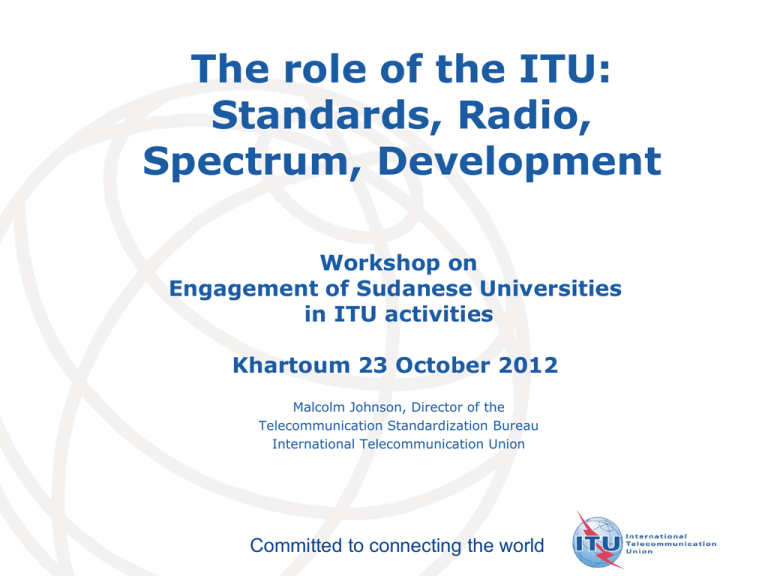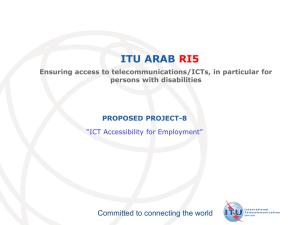The role of the ITU: Standards, Radio, Spectrum, Development Workshop on
advertisement

The role of the ITU: Standards, Radio, Spectrum, Development Workshop on Engagement of Sudanese Universities in ITU activities Khartoum 23 October 2012 Malcolm Johnson, Director of the Telecommunication Standardization Bureau International Telecommunication Union Committed to connecting the world International Telecommunication Union ITU : enabling communication since 1865 1865 2015 Committed to connecting the world ITU: a unique Membership 193 Member States and regulatory bodies 700 companies 50 Universities Business associations Research Establishments International organizations NGOs Committed to connecting the world International Telecommunication Union Leading Private Sector Members Committed to connecting the world ITU truly International and has Global presence 760 Staff from 80 Countries 6 UN Official Languages: Arabic, Chinese, English, French, Russian, Spanish Headquarters in Geneva with Liaison Office in New York Regional offices in Addis Ababa, Bangkok, Brasilia, Cairo Area offices in Bridgetown, Dakar, Harare, Jakarta, Moscow, Santiago, Tegucigalpa, Yaoundé Committed to connecting the world ITU Structure ITU-R coordinates global wireless communication (which uses limited resources) ITU-D provides assistance to the un-connected ITU-T produces interoperable technical ICT standards The GS provides intersectoral coordination for the whole organization Committed to connecting the world Key Issues in ITU-R: The Radiocommunication Sector Management of limited natural resources: Radio-frequency spectrum and satellite orbits Committed to connecting the world ITU-R plays a key role managing radiocommunications Allocates spectrum for communications (including mobile and broadcasting) Satellite communications Spectrum for advanced aeronautical communications Global maritime communications – distress channels, ship-to-shore Protects frequencies for Earth-exploration satellites to monitor resources, emergencies, meteorology and climate change Radio astronomy, space exploration Committed to connecting the world Key Issues in ITU-D: The Development Sector Assisting developing countries in putting into practice competitive ICT markets Building capacity in developing and least developed countries Measuring the advance of the Info. Society (ICT Development Index) Executing agency of UN for ICT projects, working with governments and industry partners Mobilizing resources and partners for project implementation Committed to connecting the world Bridging the Digital Divide and Connecting the Unconnected Spread equitable, sustainable and affordable access to ICTs Mobilize technical, human, financial resources needed for the implementation of ICTs in developing countries Committed to connecting the world ITU-T’s strategic goals To develop interoperable, non-discriminatory international standards (ITU-T Recommendations) To assist in bridging the standardization gap between developed and developing countries To extend and facilitate international cooperation among international, regional and national standardization bodies Committed to connecting the world One-Stop Shop for Global ICT Standards Study Groups cover a wide area of topics: Operational aspects of service provisioning Future networks Tariff and accounting Access and transport network infrastructures ICT, environment and climate change Multimedia systems and applications Test specifications Security Performance, QoS and QoE Internet of things Committed to connecting the world Recent ITU-T Success Stories Committed to connecting the world Bridging the standardization gap Workshops and seminars anywhere in the world Voluntary BSG Fund Fellowships (travel and/or hotel) SG vice-chairmen from developing countries Reduced fee for Sector Members from developing countries Committed to connecting the world 14 World Telecommunication Standardization Assembly (WTSA-12) Dubai World Trade Centre, UAE 20-29 November 2012 Committed to connecting the world 15 What is WTSA? Sets direction, policy, structure for ITU-T Meets every four years Defines the general policy for the Sector Establishes ITU-T study groups Approves work program of study groups Appoints chairs and vice-chairs of study groups Reviews existing WTSA Resolutions (49) Committed to connecting the world Main objectives Underline ITU-T’s role as the most effective venue for international standardization Pick up new work on emerging technologies Increase efficiency in order to make best use of delegate time and resources Avoid duplication and overlap of work Increase participation and relevance Committed to connecting the world Stronger presence in certain areas e-Health Accessibility ICTs and climate change Internet of Things/M2M Intelligent Transport Systems Cybersecurity including Identity management IPTV, cloud computing and smart grid Conformity and interoperability Committed to connecting the world WTSA Side Events and Exhibition Three Side Events: e-Health ICT innovation and standards Network resilience and disaster relief Academia event Showcasing 10 companies IPTV, home networking, etc. Committed to connecting the world Global Standards Symposium Monday, 19 Nov 2012 Intersection of the ICT sector with other vertical sectors such as health care, utilities, and transport Collaboration with other standards bodies Chairman will present conclusions to WTSA Committed to connecting the world World Conference on International Telecommunications (WCIT) Dubai World Trade Centre, UAE 3-14 December 2012 Committed to connecting the world ITRs the only global telecoms treaty Current ITRs provided the foundations for the ‘mobile miracle’ and Internet. Revised treaty can create a ‘broadband miracle’ Committed to connecting the world Need to revise the ITRs The international telecom environment has significantly evolved, since ‘88 both from technical and policy perspectives Advances in technology mean an increased use of IP-enabled infrastructure Member States need to adapt policy and regulatory approaches Committed to connecting the world Key topics Mobile roaming; prevention of fraud; misuse of the telephone numbering system; incentives for investment in the telecommunication network; and the empowerment of consumers. Committed to connecting the world



